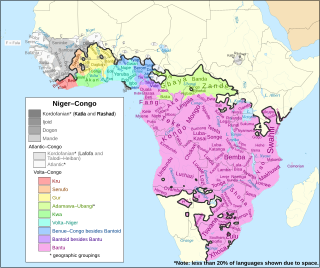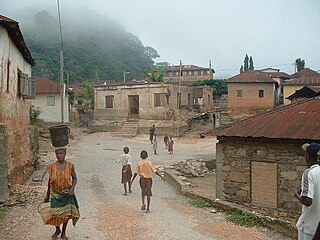Related Research Articles

The Kwa languages, often specified as New Kwa, are a proposed but as-yet-undemonstrated family of languages spoken in the south-eastern part of Ivory Coast, across southern Ghana, and in central Togo. The name was introduced 1895 by Gottlob Krause and derives from the word for 'people' (Kwa) in many of these languages, as illustrated by Akan names.

Benue–Congo is a major branch of the Volta-Congo languages which covers most of Sub-Saharan Africa.
Jalaa, also known as Cèntûm, Centúúm or Cen Tuum, is an extinct language of northeastern Nigeria, of uncertain origins, apparently a language isolate. The Jalabe speak the Bwilim dialect of the Dikaka language. It is possible that some remembered words have been retained for religious ceremonies, but in 1992 only a few elders remember words that their parents had used, and by 2010 there may not even remain any such rememberers.
The Kujargé language is spoken in seven villages in eastern Chad near Jebel Mirra, and in villages scattered along the lower Wadi Salih and Wadi Azum in Darfur, Sudan. It is estimated to have about 1000 speakers.
The Adamawa languages are a putative family of 80–90 languages scattered across the Adamawa Plateau in Central Africa, in northern Cameroon, north-western Central African Republic, southern Chad, and eastern Nigeria, spoken altogether by only one and a half million people. Joseph Greenberg classified them as one branch of the Adamawa–Ubangi family of Niger–Congo languages. They are among the least studied languages in Africa, and include many endangered languages; by far the largest is Mumuye, with 400,000 speakers. A couple of unclassified languages—notably Laal and Jalaa—are found along the fringes of the Adamawa area.

Volta–Congo is a major branch of the Atlantic–Congo family. It includes all the Niger-Congo languages and subfamilies except the families of the erstwhile Atlantic and Kordofanian branches, Mande, Dogon, and Ijo. It thus only differs from Atlantic–Congo in that it excludes the Atlantic languages and, in some conceptions, Kru and Senufo.

The Ghana–Togo Mountain languages, formerly called Togorestsprachen and Central Togo languages, form a grouping of about fourteen languages spoken in the mountains of the Ghana–Togo borderland. They are part of the Kwa branch of the Niger–Congo family.

Ghana is a multilingual country in which about eighty languages are spoken. Of these, English, which was inherited from the colonial era, is the official language and lingua franca. Of the languages indigenous to Ghana, Akan is the most widely spoken in the south. Dagbani is most widely spoken in the north.
Animere is a language spoken in Ghana, in the Kecheibe and Kunda villages of the Benimbere people. It is most closely related to Kebu or Akebu of Togo. Both are Ghana Togo Mountain languages (GTM), classified as members of the Ka-Togo group by Heine (1968). Like most other GTM languages, Animere is a noun-class language.
Mbre or Pere, known as Pεrε among themselves and as Bεrε by the locally dominant Koro, also spelled Pre and Bre, is an moribund language of the Ivory Coast.
Ega, also known as Egwa and Diès, is a West African language spoken in south-central Ivory Coast. It is of uncertain affiliation and has variously been classified as Kwa or an independent branch of Niger-Congo.
The Guan languages are languages of the Kwa language family spoken by the Guan people in Ghana and Togo:

ʼOle, also called ʼOlekha or Black Mountain Monpa, is possibly a Sino-Tibetan language spoken by about 1,000 people in the Black Mountains of Wangdue Phodrang and Trongsa Districts in western Bhutan. The term ʼOle refers to a clan of speakers.
Buru and Angwe constitute a potentially rather divergent Southern Bantoid language spoken in Sardauna LGA, Taraba State of Nigeria.
Bugun, also known as Khowa, is a small possible language isolate spoken in Arunachal Pradesh state of India by the Bugun. They numbered about 1,700 in 2011.
Hruso, also known as Aka (Angka), is a language of Arunachal Pradesh India. Long assumed to be a Sino-Tibetan language, it may actually be a language isolate. It is spoken by 3,000 people in 21 villages in Thrizino Circle, West Kameng District. The Hruso people inhabit areas of South East Kameng and are concentrated in the Bichom River Valley, and speak English, Hindi, and Miji in addition to Hruso.
Miji, also given the dialect names Sajolang and Dhammai, is a dialect cluster traditionally counted as one of the Sino-Tibetan languages that is spoken in Arunachal Pradesh, northeastern India. The varieties are not particularly close, with only half of the vocabulary in common between the languages of East Kameng District and West Kameng District. Long assumed to be Sino-Tibetan languages, Miji and the recently discovered Bangru language may instead form a small independent language family.
The Siangic languages are a small family of possibly Sino-Tibetan languages spoken in Arunachal Pradesh, northeast India. The Siangic languages consist of Koro and Milang.
Dompo is an endangered language of Ghana. Speakers are shifting to Nafaanra. It is spoken adjacent to the main town of the Nafaanra people, namely Banda, Brong-Ahafo Region, Ghana. Blench (2015) reports that it is spoken by 10 households.
Mpur is an unclassified and unattested language once spoken in the village of Tuluwe at the confluence of the Black and White Voltas, and in Kusawgu Division. It is near the poorly attested language Mpra spoken in the nearby village of Butie, which may turn out to be a language isolate, though the Mpra people come from further west.
References
- ↑ Painter (1967)
- ↑ Blench, Roger (2007) Recovering data on Mpra [=Mpre] a possible language isolate in North-Central Ghana
- ↑ Roger Blench, Niger-Congo: an alternative view